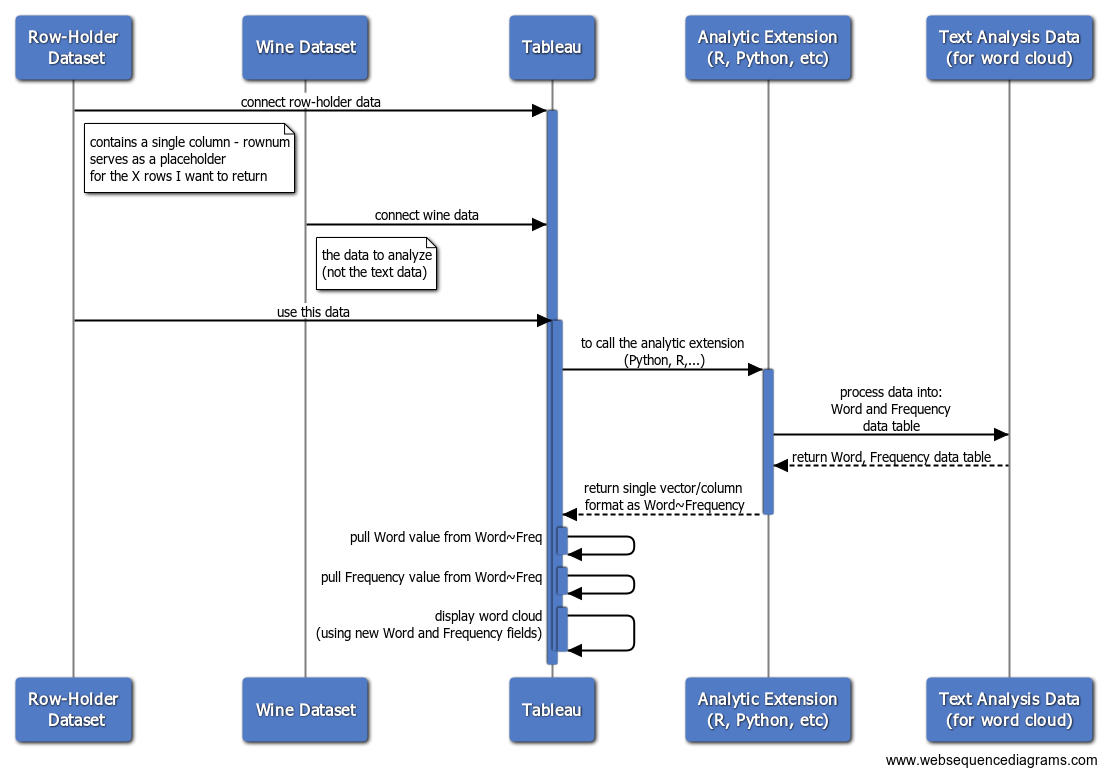I worked on a project in R a while back that did something pretty similar. Here's an example of a video demonstrating the proof-of-concept (no audio). It effectively depicts the ultimate result of using Tableau to interactively explore wine descriptions in a word cloud for the chosen nations. The following were the most important elements:
Tableau connects to the data to be analysed, as well as a placeholder dataset containing the number of records you anticipate to get from your Python/R code (Tableau expects to receive the same number of records back from Python/R as it sends forth to be processed). It can be a problem if you're transmitting text data but processing it to produce a large number of records (as in the word cloud example).
The Word and Frequency counts are returned in a single vector, separated by a delimiter, by Python/R code that connects to your data (what Tableau will require for a word cloud).
Tableau Calculated Fields are used to split the single vector and parameter actions are used to pick parameter values to pass to the Python/R code.

Tableau Calculated Field - [R Words+Freq]:
Script_Str('
print("STARTING NEW SCRIPT RUN")
print(Sys.time())
print(.arg2) # grouping
print(.arg1) # selected country
# TEST VARIABLE (non-prod)
.MaxSourceDataRecords = 1000 # -1 to disable
# TABLEAU PARAMETER VARIABLES
.country = "' + [Country Parameter] + '"
.wordsToReturn = ' + str([Return Top N Words]) + '
#^^^^^^^^^^^^^^^^^^^^^^^^^^^^^^^^^^^^^^^^^^^^^^^^^^^#
# VARIABLES DERIVED FROM TABLEAU PARAMETER VALUES
.countryUseAll = (.country == "All")
print(.countryUseAll)
#^^^^^^^^^^^^^^^^^^^^^^^^^^^^^^^^^^^^^^^^^^^^^^^^^^^#
#setwd("C:/Users/jbelliveau/....FILL IN HERE...")
.fileIn = ' + [Source Data Path] + '
#.fileOut = "winemag-with-DTM.csv"
#install.packages("wordcloud")
#install.packages("RColorBrewer") # not needed if installed wordcloud package
library(tm)
library(wordcloud)
library(RColorBrewer) # color package (maps or wordclouds)
wineAll = read.csv(.fileIn, stringsAsFactors=FALSE)
# TODO separately... polarity
# use all the data or just the parameter selected
print(.countryUseAll)
if ( .countryUseAll ) {
wine = wineAll # filter down to parameter passed from Tableau
}else{
wine = wineAll[c(wineAll$country == .country),] # filter down to parameter passed from Tableau
}
# limited data for speed (NOT FOR PRODUCTION)
if( .MaxSourceDataRecords > 0 ){
print("limiting the number of records to use from input data")
wine = head(wine, .MaxSourceDataRecords)
}
corpus = Corpus(VectorSource(wine$description))
corpus = tm_map(corpus, tolower)
#corpus = tm_map(corpus, PlainTextDocument)
corpus = tm_map(corpus, removePunctuation)
corpus = tm_map(corpus, removeWords, stopwords("English"))
#length(corpus)
dtm = DocumentTermMatrix(corpus)
#?sample
mysample = dtm # no sampling (used Head on data read... for speed/simplicity on this example)
#mysample <- dtm[sample(1:nrow(dtm), 5000, replace=FALSE),]
#nrow(mysample)
wineSample = as.data.frame(as.matrix(mysample))
# column names (the words)
# use colnames to get a vector of the words
#colnames(wineSample)
# freq of words
# colSums to get the frequency of the words
#wineWordFreq = colSums(wineSample)
# structure in a way Tableau will like it
wordCloudData = data.frame(words=colnames(wineSample), freq=colSums(wineSample))
str(wordCloudData)
# sort by word freq
wordCloudDataSorted = wordCloudData[order(-wordCloudData$freq),]
# join together by ~ for processing once Tableau gets it
wordAndFreq = paste(wordCloudDataSorted[, 1], wordCloudDataSorted[, 2], sep = "~")
#write.table(wordCloudData, .fileOut, sep=",",row.names=FALSE) # if needed for performance refactors
topWords = head(wordAndFreq, .wordsToReturn)
#print(topWords)
return( topWords )
',
Max([Country Parameter])
, MAX([RowNum]) // for testing the grouping being sent to R
)
Tableau Calculated Field for the Word Value:
// grab the first token to the left of ~
Left([R Words+Freq], Find([R Words+Freq],"~") - 1)
Tableau Calculated Field for the Frequency Value:
INT(REPLACE([R Words+Freq],[Word]+"~",""))
If you're not familiar with Tableau, you'll probably want to work with someone who is. They'll be able to assist you with creating calculated fields and connecting Tableau to TabPy.
 REGISTER FOR FREE WEBINAR
X
REGISTER FOR FREE WEBINAR
X
 Thank you for registering
Join Edureka Meetup community for 100+ Free Webinars each month
JOIN MEETUP GROUP
Thank you for registering
Join Edureka Meetup community for 100+ Free Webinars each month
JOIN MEETUP GROUP